trailer GMC SAVANA 2021 Owner's Manual
[x] Cancel search | Manufacturer: GMC, Model Year: 2021, Model line: SAVANA, Model: GMC SAVANA 2021Pages: 292, PDF Size: 6.38 MB
Page 7 of 292
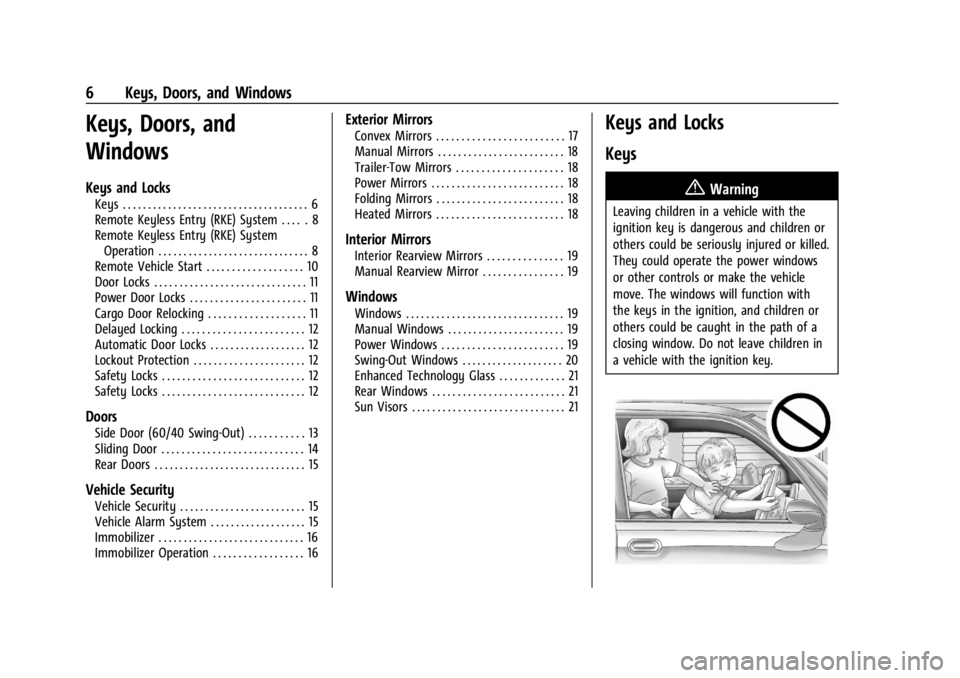
GMC Savana Owner Manual (GMNA-Localizing-U.S./Canada-14583543) -
2021 - crc - 7/10/20
6 Keys, Doors, and Windows
Keys, Doors, and
Windows
Keys and Locks
Keys . . . . . . . . . . . . . . . . . . . . . . . . . . . . . . . . . . . . . 6
Remote Keyless Entry (RKE) System . . . . . 8
Remote Keyless Entry (RKE) SystemOperation . . . . . . . . . . . . . . . . . . . . . . . . . . . . . . 8
Remote Vehicle Start . . . . . . . . . . . . . . . . . . . 10
Door Locks . . . . . . . . . . . . . . . . . . . . . . . . . . . . . . 11
Power Door Locks . . . . . . . . . . . . . . . . . . . . . . . 11
Cargo Door Relocking . . . . . . . . . . . . . . . . . . . 11
Delayed Locking . . . . . . . . . . . . . . . . . . . . . . . . 12
Automatic Door Locks . . . . . . . . . . . . . . . . . . . 12
Lockout Protection . . . . . . . . . . . . . . . . . . . . . . 12
Safety Locks . . . . . . . . . . . . . . . . . . . . . . . . . . . . 12
Safety Locks . . . . . . . . . . . . . . . . . . . . . . . . . . . . 12
Doors
Side Door (60/40 Swing-Out) . . . . . . . . . . . 13
Sliding Door . . . . . . . . . . . . . . . . . . . . . . . . . . . . 14
Rear Doors . . . . . . . . . . . . . . . . . . . . . . . . . . . . . . 15
Vehicle Security
Vehicle Security . . . . . . . . . . . . . . . . . . . . . . . . . 15
Vehicle Alarm System . . . . . . . . . . . . . . . . . . . 15
Immobilizer . . . . . . . . . . . . . . . . . . . . . . . . . . . . . 16
Immobilizer Operation . . . . . . . . . . . . . . . . . . 16
Exterior Mirrors
Convex Mirrors . . . . . . . . . . . . . . . . . . . . . . . . . 17
Manual Mirrors . . . . . . . . . . . . . . . . . . . . . . . . . 18
Trailer-Tow Mirrors . . . . . . . . . . . . . . . . . . . . . 18
Power Mirrors . . . . . . . . . . . . . . . . . . . . . . . . . . 18
Folding Mirrors . . . . . . . . . . . . . . . . . . . . . . . . . 18
Heated Mirrors . . . . . . . . . . . . . . . . . . . . . . . . . 18
Interior Mirrors
Interior Rearview Mirrors . . . . . . . . . . . . . . . 19
Manual Rearview Mirror . . . . . . . . . . . . . . . . 19
Windows
Windows . . . . . . . . . . . . . . . . . . . . . . . . . . . . . . . 19
Manual Windows . . . . . . . . . . . . . . . . . . . . . . . 19
Power Windows . . . . . . . . . . . . . . . . . . . . . . . . 19
Swing-Out Windows . . . . . . . . . . . . . . . . . . . . 20
Enhanced Technology Glass . . . . . . . . . . . . . 21
Rear Windows . . . . . . . . . . . . . . . . . . . . . . . . . . 21
Sun Visors . . . . . . . . . . . . . . . . . . . . . . . . . . . . . . 21
Keys and Locks
Keys
{Warning
Leaving children in a vehicle with the
ignition key is dangerous and children or
others could be seriously injured or killed.
They could operate the power windows
or other controls or make the vehicle
move. The windows will function with
the keys in the ignition, and children or
others could be caught in the path of a
closing window. Do not leave children in
a vehicle with the ignition key.
Page 19 of 292
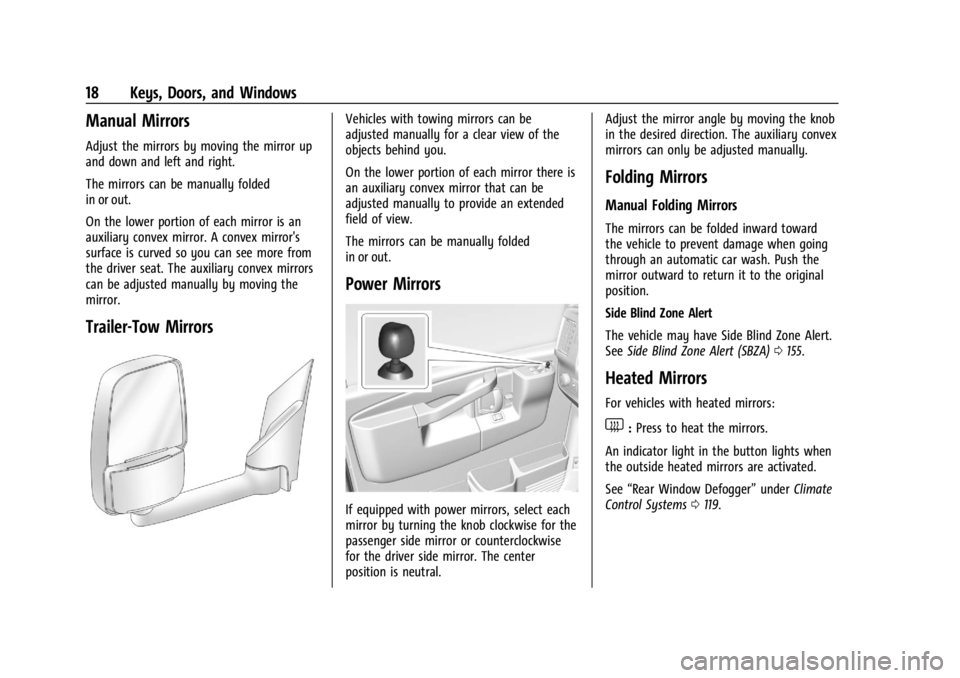
GMC Savana Owner Manual (GMNA-Localizing-U.S./Canada-14583543) -
2021 - crc - 7/10/20
18 Keys, Doors, and Windows
Manual Mirrors
Adjust the mirrors by moving the mirror up
and down and left and right.
The mirrors can be manually folded
in or out.
On the lower portion of each mirror is an
auxiliary convex mirror. A convex mirror's
surface is curved so you can see more from
the driver seat. The auxiliary convex mirrors
can be adjusted manually by moving the
mirror.
Trailer-Tow Mirrors
Vehicles with towing mirrors can be
adjusted manually for a clear view of the
objects behind you.
On the lower portion of each mirror there is
an auxiliary convex mirror that can be
adjusted manually to provide an extended
field of view.
The mirrors can be manually folded
in or out.
Power Mirrors
If equipped with power mirrors, select each
mirror by turning the knob clockwise for the
passenger side mirror or counterclockwise
for the driver side mirror. The center
position is neutral.Adjust the mirror angle by moving the knob
in the desired direction. The auxiliary convex
mirrors can only be adjusted manually.
Folding Mirrors
Manual Folding Mirrors
The mirrors can be folded inward toward
the vehicle to prevent damage when going
through an automatic car wash. Push the
mirror outward to return it to the original
position.
Side Blind Zone Alert
The vehicle may have Side Blind Zone Alert.
See
Side Blind Zone Alert (SBZA) 0155.
Heated Mirrors
For vehicles with heated mirrors:
1:Press to heat the mirrors.
An indicator light in the button lights when
the outside heated mirrors are activated.
See “Rear Window Defogger” underClimate
Control Systems 0119.
Page 77 of 292
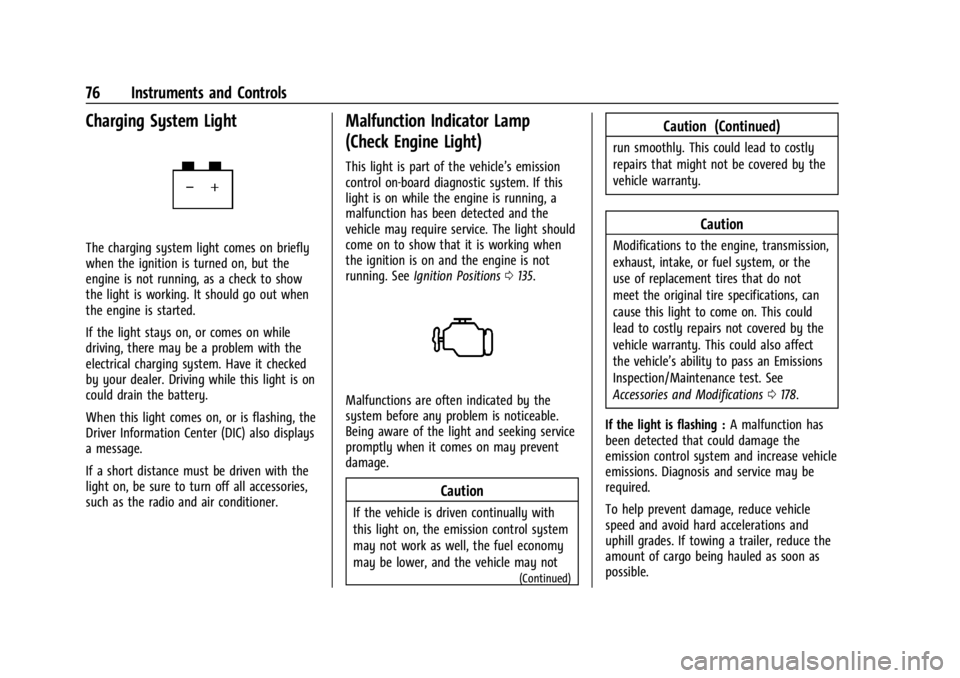
GMC Savana Owner Manual (GMNA-Localizing-U.S./Canada-14583543) -
2021 - crc - 7/10/20
76 Instruments and Controls
Charging System Light
The charging system light comes on briefly
when the ignition is turned on, but the
engine is not running, as a check to show
the light is working. It should go out when
the engine is started.
If the light stays on, or comes on while
driving, there may be a problem with the
electrical charging system. Have it checked
by your dealer. Driving while this light is on
could drain the battery.
When this light comes on, or is flashing, the
Driver Information Center (DIC) also displays
a message.
If a short distance must be driven with the
light on, be sure to turn off all accessories,
such as the radio and air conditioner.
Malfunction Indicator Lamp
(Check Engine Light)
This light is part of the vehicle’s emission
control on-board diagnostic system. If this
light is on while the engine is running, a
malfunction has been detected and the
vehicle may require service. The light should
come on to show that it is working when
the ignition is on and the engine is not
running. SeeIgnition Positions 0135.
Malfunctions are often indicated by the
system before any problem is noticeable.
Being aware of the light and seeking service
promptly when it comes on may prevent
damage.
Caution
If the vehicle is driven continually with
this light on, the emission control system
may not work as well, the fuel economy
may be lower, and the vehicle may not
(Continued)
Caution (Continued)
run smoothly. This could lead to costly
repairs that might not be covered by the
vehicle warranty.
Caution
Modifications to the engine, transmission,
exhaust, intake, or fuel system, or the
use of replacement tires that do not
meet the original tire specifications, can
cause this light to come on. This could
lead to costly repairs not covered by the
vehicle warranty. This could also affect
the vehicle’s ability to pass an Emissions
Inspection/Maintenance test. See
Accessories and Modifications 0178.
If the light is flashing : A malfunction has
been detected that could damage the
emission control system and increase vehicle
emissions. Diagnosis and service may be
required.
To help prevent damage, reduce vehicle
speed and avoid hard accelerations and
uphill grades. If towing a trailer, reduce the
amount of cargo being hauled as soon as
possible.
Page 96 of 292

GMC Savana Owner Manual (GMNA-Localizing-U.S./Canada-14583543) -
2021 - crc - 7/10/20
Lighting 95
When the battery's state of charge is low,
the voltage is raised slightly to quickly bring
the charge back up. When the state of
charge is high, the voltage is lowered
slightly to prevent overcharging. If the
vehicle has a voltmeter gauge or a voltage
display on the Driver Information Center
(DIC), you may see the voltage move up or
down. This is normal. If there is a problem,
an alert will be displayed.
The battery can be discharged at idle if the
electrical loads are very high. This is true for
all vehicles. This is because the generator
(alternator) may not be spinning fast
enough at idle to produce all the power that
is needed for very high electrical loads.
A high electrical load occurs when several of
the following are on, such as: headlamps,
high beams, fog lamps, rear window
defogger, climate control fan at high speed,
heated seats, engine cooling fans, trailer
loads, and loads plugged into accessory
power outlets.EPM works to prevent excessive discharge of
the battery. It does this by balancing the
generator's output and the vehicle's
electrical needs. It can increase engine idle
speed to generate more power, whenever
needed. It can temporarily reduce the power
demands of some accessories.
Normally, these actions occur in steps or
levels, without being noticeable. In rare
cases at the highest levels of corrective
action, this action may be noticeable to the
driver. If so, a Driver Information Center
(DIC) message might be displayed, such as
SERVICE BATTERY CHARGING SYSTEM. If this
messages displays, it is recommended that
the driver reduce the electrical loads as
much as possible.
Battery Power Protection
This feature shuts off the interior lamps if
they are left on for more than 10 minutes
when the ignition is off. This helps to
prevent the battery from running down.
Exterior Lighting Battery Saver
The exterior lamps turn off about 10 minutes
after the ignition is turned off, if the parking
lamps or headlamps have been manually
left on. This protects against draining the
battery. To restart the 10-minute timer, turn
the exterior lamp control to the
Oposition
and then back to the
;or2position.
To keep the lamps on for more than
10 minutes, the ignition must be on or in
ACC/ACCESSORY.
Page 126 of 292
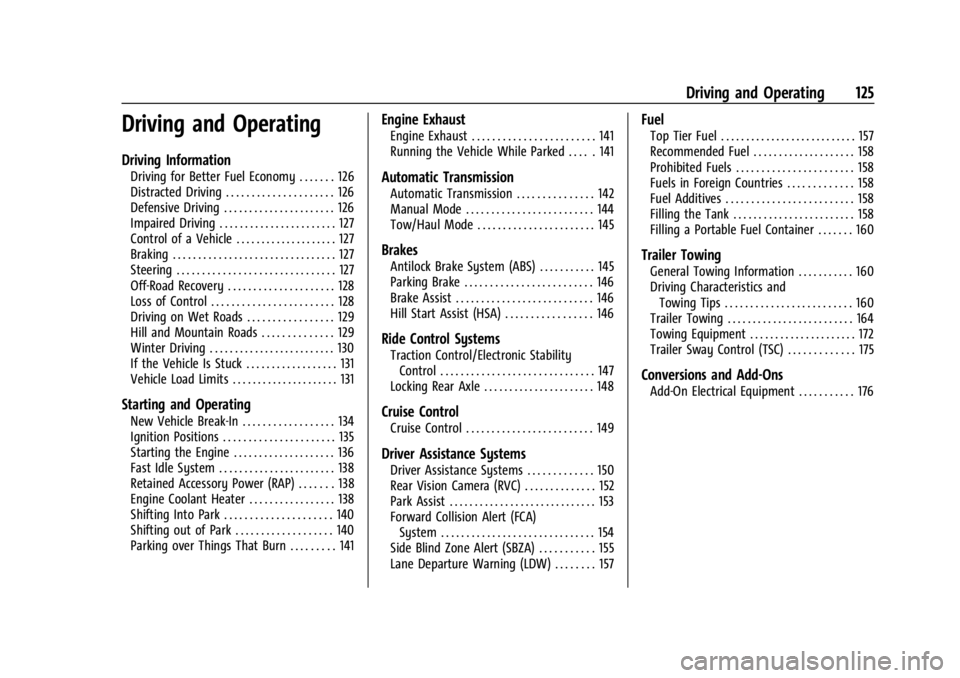
GMC Savana Owner Manual (GMNA-Localizing-U.S./Canada-14583543) -
2021 - crc - 7/10/20
Driving and Operating 125
Driving and Operating
Driving Information
Driving for Better Fuel Economy . . . . . . . 126
Distracted Driving . . . . . . . . . . . . . . . . . . . . . 126
Defensive Driving . . . . . . . . . . . . . . . . . . . . . . 126
Impaired Driving . . . . . . . . . . . . . . . . . . . . . . . 127
Control of a Vehicle . . . . . . . . . . . . . . . . . . . . 127
Braking . . . . . . . . . . . . . . . . . . . . . . . . . . . . . . . . 127
Steering . . . . . . . . . . . . . . . . . . . . . . . . . . . . . . . 127
Off-Road Recovery . . . . . . . . . . . . . . . . . . . . . 128
Loss of Control . . . . . . . . . . . . . . . . . . . . . . . . 128
Driving on Wet Roads . . . . . . . . . . . . . . . . . 129
Hill and Mountain Roads . . . . . . . . . . . . . . 129
Winter Driving . . . . . . . . . . . . . . . . . . . . . . . . . 130
If the Vehicle Is Stuck . . . . . . . . . . . . . . . . . . 131
Vehicle Load Limits . . . . . . . . . . . . . . . . . . . . . 131
Starting and Operating
New Vehicle Break-In . . . . . . . . . . . . . . . . . . 134
Ignition Positions . . . . . . . . . . . . . . . . . . . . . . 135
Starting the Engine . . . . . . . . . . . . . . . . . . . . 136
Fast Idle System . . . . . . . . . . . . . . . . . . . . . . . 138
Retained Accessory Power (RAP) . . . . . . . 138
Engine Coolant Heater . . . . . . . . . . . . . . . . . 138
Shifting Into Park . . . . . . . . . . . . . . . . . . . . . 140
Shifting out of Park . . . . . . . . . . . . . . . . . . . 140
Parking over Things That Burn . . . . . . . . . 141
Engine Exhaust
Engine Exhaust . . . . . . . . . . . . . . . . . . . . . . . . 141
Running the Vehicle While Parked . . . . . 141
Automatic Transmission
Automatic Transmission . . . . . . . . . . . . . . . 142
Manual Mode . . . . . . . . . . . . . . . . . . . . . . . . . 144
Tow/Haul Mode . . . . . . . . . . . . . . . . . . . . . . . 145
Brakes
Antilock Brake System (ABS) . . . . . . . . . . . 145
Parking Brake . . . . . . . . . . . . . . . . . . . . . . . . . 146
Brake Assist . . . . . . . . . . . . . . . . . . . . . . . . . . . 146
Hill Start Assist (HSA) . . . . . . . . . . . . . . . . . 146
Ride Control Systems
Traction Control/Electronic StabilityControl . . . . . . . . . . . . . . . . . . . . . . . . . . . . . . 147
Locking Rear Axle . . . . . . . . . . . . . . . . . . . . . . 148
Cruise Control
Cruise Control . . . . . . . . . . . . . . . . . . . . . . . . . 149
Driver Assistance Systems
Driver Assistance Systems . . . . . . . . . . . . . 150
Rear Vision Camera (RVC) . . . . . . . . . . . . . . 152
Park Assist . . . . . . . . . . . . . . . . . . . . . . . . . . . . . 153
Forward Collision Alert (FCA) System . . . . . . . . . . . . . . . . . . . . . . . . . . . . . . 154
Side Blind Zone Alert (SBZA) . . . . . . . . . . . 155
Lane Departure Warning (LDW) . . . . . . . . 157
Fuel
Top Tier Fuel . . . . . . . . . . . . . . . . . . . . . . . . . . . 157
Recommended Fuel . . . . . . . . . . . . . . . . . . . . 158
Prohibited Fuels . . . . . . . . . . . . . . . . . . . . . . . 158
Fuels in Foreign Countries . . . . . . . . . . . . . 158
Fuel Additives . . . . . . . . . . . . . . . . . . . . . . . . . 158
Filling the Tank . . . . . . . . . . . . . . . . . . . . . . . . 158
Filling a Portable Fuel Container . . . . . . . 160
Trailer Towing
General Towing Information . . . . . . . . . . . 160
Driving Characteristics and Towing Tips . . . . . . . . . . . . . . . . . . . . . . . . . 160
Trailer Towing . . . . . . . . . . . . . . . . . . . . . . . . . 164
Towing Equipment . . . . . . . . . . . . . . . . . . . . . 172
Trailer Sway Control (TSC) . . . . . . . . . . . . . 175
Conversions and Add-Ons
Add-On Electrical Equipment . . . . . . . . . . . 176
Page 133 of 292
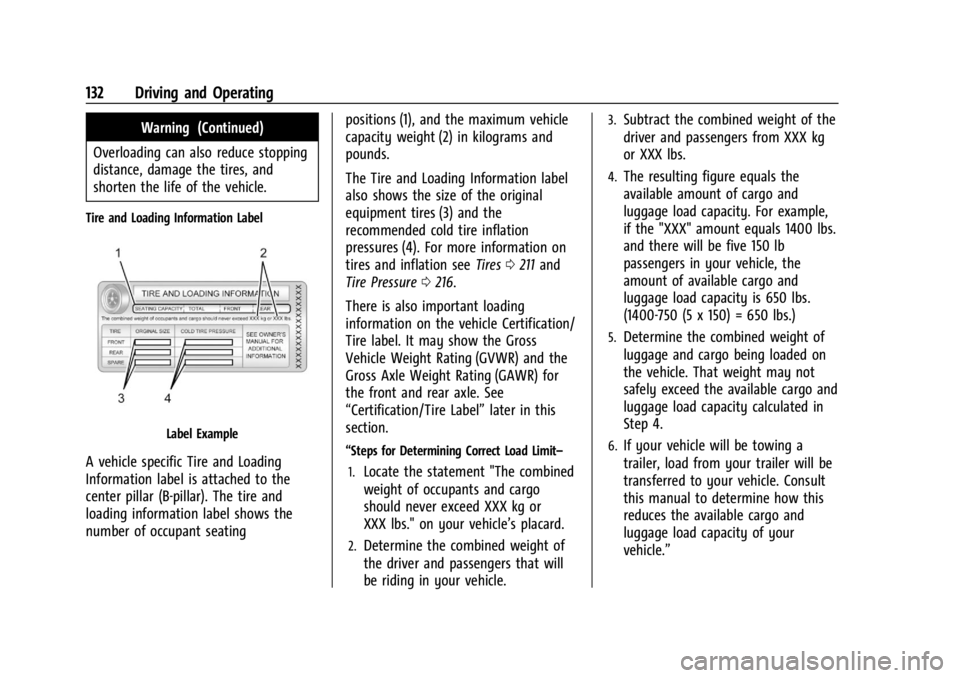
GMC Savana Owner Manual (GMNA-Localizing-U.S./Canada-14583543) -
2021 - crc - 7/10/20
132 Driving and Operating
Warning (Continued)
Overloading can also reduce stopping
distance, damage the tires, and
shorten the life of the vehicle.
Tire and Loading Information Label
Label Example
A vehicle specific Tire and Loading
Information label is attached to the
center pillar (B-pillar). The tire and
loading information label shows the
number of occupant seating positions (1), and the maximum vehicle
capacity weight (2) in kilograms and
pounds.
The Tire and Loading Information label
also shows the size of the original
equipment tires (3) and the
recommended cold tire inflation
pressures (4). For more information on
tires and inflation see
Tires0211 and
Tire Pressure 0216.
There is also important loading
information on the vehicle Certification/
Tire label. It may show the Gross
Vehicle Weight Rating (GVWR) and the
Gross Axle Weight Rating (GAWR) for
the front and rear axle. See
“Certification/Tire Label” later in this
section.“Steps for Determining Correct Load Limit–
1.
Locate the statement "The combined
weight of occupants and cargo
should never exceed XXX kg or
XXX lbs." on your vehicle’s placard.
2.Determine the combined weight of
the driver and passengers that will
be riding in your vehicle.
3.Subtract the combined weight of the
driver and passengers from XXX kg
or XXX lbs.
4.The resulting figure equals the
available amount of cargo and
luggage load capacity. For example,
if the "XXX" amount equals 1400 lbs.
and there will be five 150 lb
passengers in your vehicle, the
amount of available cargo and
luggage load capacity is 650 lbs.
(1400-750 (5 x 150) = 650 lbs.)
5.Determine the combined weight of
luggage and cargo being loaded on
the vehicle. That weight may not
safely exceed the available cargo and
luggage load capacity calculated in
Step 4.
6.If your vehicle will be towing a
trailer, load from your trailer will be
transferred to your vehicle. Consult
this manual to determine how this
reduces the available cargo and
luggage load capacity of your
vehicle.”
Page 134 of 292
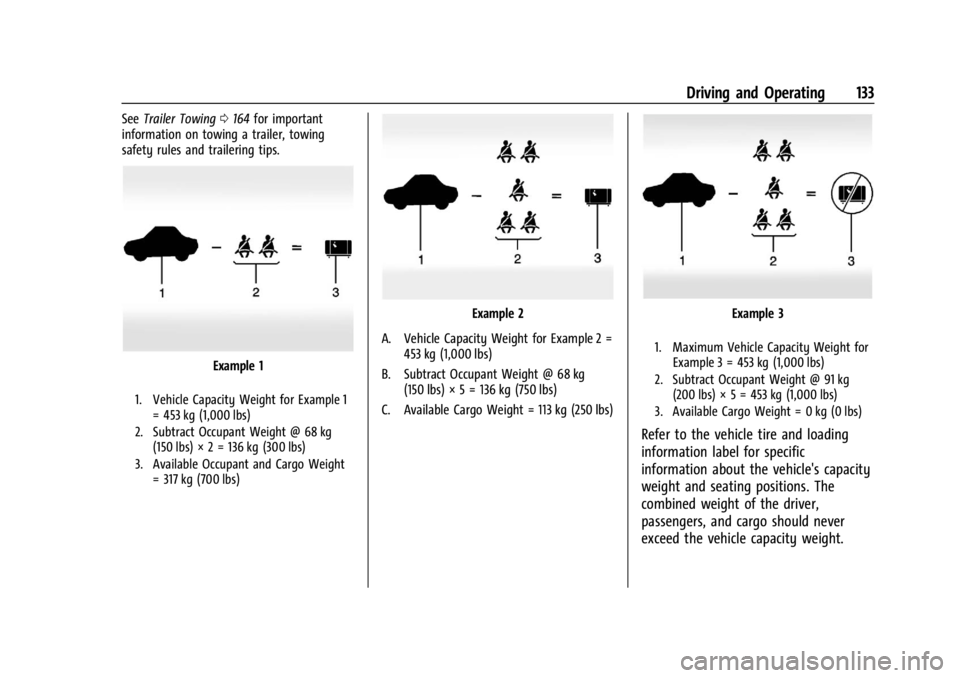
GMC Savana Owner Manual (GMNA-Localizing-U.S./Canada-14583543) -
2021 - crc - 7/10/20
Driving and Operating 133
SeeTrailer Towing 0164 for important
information on towing a trailer, towing
safety rules and trailering tips.
Example 1
1. Vehicle Capacity Weight for Example 1 = 453 kg (1,000 lbs)
2. Subtract Occupant Weight @ 68 kg (150 lbs) × 2 = 136 kg (300 lbs)
3. Available Occupant and Cargo Weight = 317 kg (700 lbs)
Example 2
A. Vehicle Capacity Weight for Example 2 = 453 kg (1,000 lbs)
B. Subtract Occupant Weight @ 68 kg (150 lbs) × 5 = 136 kg (750 lbs)
C. Available Cargo Weight = 113 kg (250 lbs)Example 3
1. Maximum Vehicle Capacity Weight for Example 3 = 453 kg (1,000 lbs)
2. Subtract Occupant Weight @ 91 kg (200 lbs) × 5 = 453 kg (1,000 lbs)
3. Available Cargo Weight = 0 kg (0 lbs)
Refer to the vehicle tire and loading
information label for specific
information about the vehicle's capacity
weight and seating positions. The
combined weight of the driver,
passengers, and cargo should never
exceed the vehicle capacity weight.
Page 136 of 292
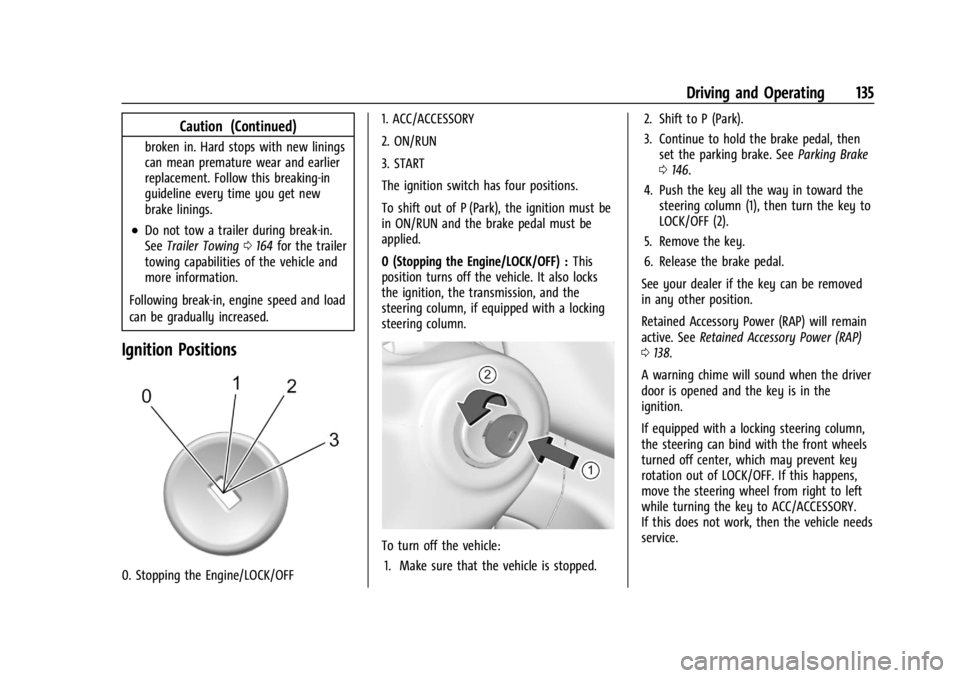
GMC Savana Owner Manual (GMNA-Localizing-U.S./Canada-14583543) -
2021 - crc - 7/10/20
Driving and Operating 135
Caution (Continued)
broken in. Hard stops with new linings
can mean premature wear and earlier
replacement. Follow this breaking-in
guideline every time you get new
brake linings.
.Do not tow a trailer during break-in.
SeeTrailer Towing 0164 for the trailer
towing capabilities of the vehicle and
more information.
Following break-in, engine speed and load
can be gradually increased.
Ignition Positions
0. Stopping the Engine/LOCK/OFF 1. ACC/ACCESSORY
2. ON/RUN
3. START
The ignition switch has four positions.
To shift out of P (Park), the ignition must be
in ON/RUN and the brake pedal must be
applied.
0 (Stopping the Engine/LOCK/OFF) :
This
position turns off the vehicle. It also locks
the ignition, the transmission, and the
steering column, if equipped with a locking
steering column.
To turn off the vehicle:
1. Make sure that the vehicle is stopped. 2. Shift to P (Park).
3. Continue to hold the brake pedal, then
set the parking brake. See Parking Brake
0 146.
4. Push the key all the way in toward the steering column (1), then turn the key to
LOCK/OFF (2).
5. Remove the key.
6. Release the brake pedal.
See your dealer if the key can be removed
in any other position.
Retained Accessory Power (RAP) will remain
active. See Retained Accessory Power (RAP)
0 138.
A warning chime will sound when the driver
door is opened and the key is in the
ignition.
If equipped with a locking steering column,
the steering can bind with the front wheels
turned off center, which may prevent key
rotation out of LOCK/OFF. If this happens,
move the steering wheel from right to left
while turning the key to ACC/ACCESSORY.
If this does not work, then the vehicle needs
service.
Page 141 of 292
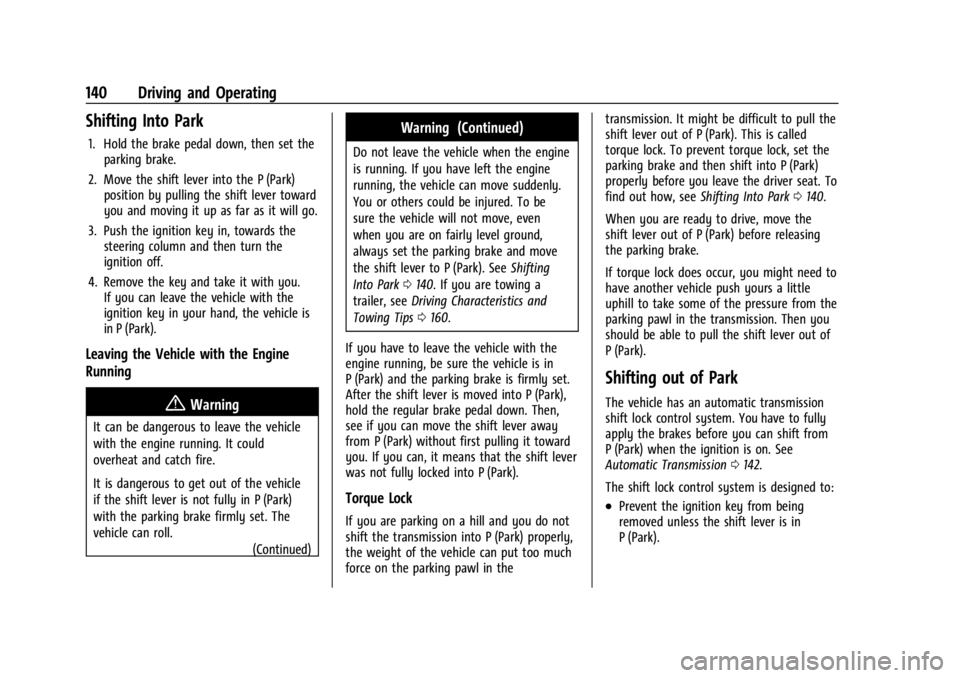
GMC Savana Owner Manual (GMNA-Localizing-U.S./Canada-14583543) -
2021 - crc - 7/10/20
140 Driving and Operating
Shifting Into Park
1. Hold the brake pedal down, then set theparking brake.
2. Move the shift lever into the P (Park) position by pulling the shift lever toward
you and moving it up as far as it will go.
3. Push the ignition key in, towards the steering column and then turn the
ignition off.
4. Remove the key and take it with you. If you can leave the vehicle with the
ignition key in your hand, the vehicle is
in P (Park).
Leaving the Vehicle with the Engine
Running
{Warning
It can be dangerous to leave the vehicle
with the engine running. It could
overheat and catch fire.
It is dangerous to get out of the vehicle
if the shift lever is not fully in P (Park)
with the parking brake firmly set. The
vehicle can roll.
(Continued)
Warning (Continued)
Do not leave the vehicle when the engine
is running. If you have left the engine
running, the vehicle can move suddenly.
You or others could be injured. To be
sure the vehicle will not move, even
when you are on fairly level ground,
always set the parking brake and move
the shift lever to P (Park). SeeShifting
Into Park 0140. If you are towing a
trailer, see Driving Characteristics and
Towing Tips 0160.
If you have to leave the vehicle with the
engine running, be sure the vehicle is in
P (Park) and the parking brake is firmly set.
After the shift lever is moved into P (Park),
hold the regular brake pedal down. Then,
see if you can move the shift lever away
from P (Park) without first pulling it toward
you. If you can, it means that the shift lever
was not fully locked into P (Park).
Torque Lock
If you are parking on a hill and you do not
shift the transmission into P (Park) properly,
the weight of the vehicle can put too much
force on the parking pawl in the transmission. It might be difficult to pull the
shift lever out of P (Park). This is called
torque lock. To prevent torque lock, set the
parking brake and then shift into P (Park)
properly before you leave the driver seat. To
find out how, see
Shifting Into Park0140.
When you are ready to drive, move the
shift lever out of P (Park) before releasing
the parking brake.
If torque lock does occur, you might need to
have another vehicle push yours a little
uphill to take some of the pressure from the
parking pawl in the transmission. Then you
should be able to pull the shift lever out of
P (Park).
Shifting out of Park
The vehicle has an automatic transmission
shift lock control system. You have to fully
apply the brakes before you can shift from
P (Park) when the ignition is on. See
Automatic Transmission 0142.
The shift lock control system is designed to:
.Prevent the ignition key from being
removed unless the shift lever is in
P (Park).
Page 143 of 292
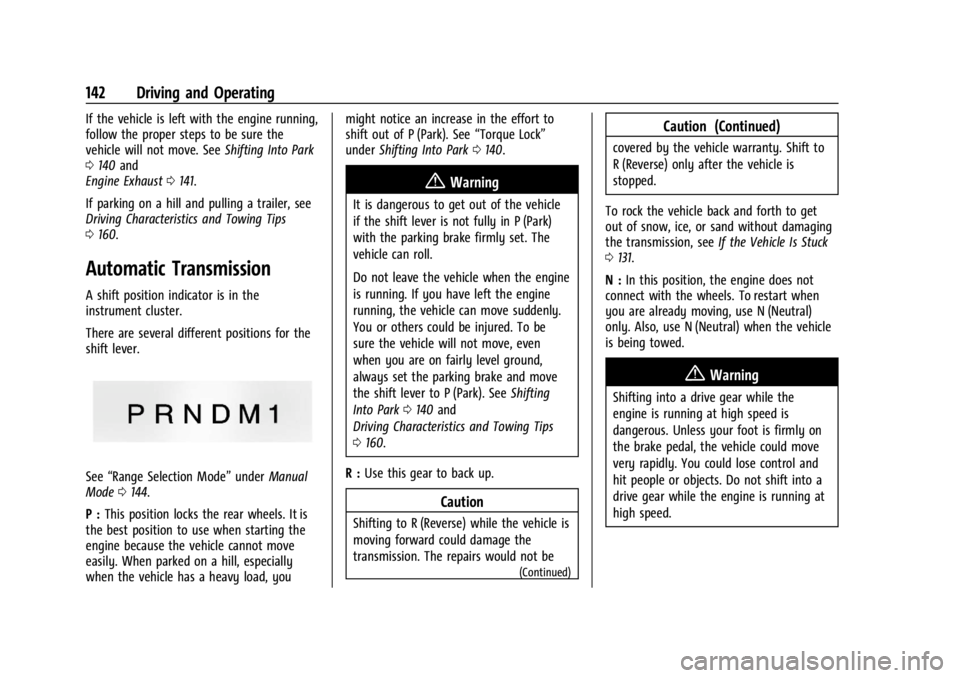
GMC Savana Owner Manual (GMNA-Localizing-U.S./Canada-14583543) -
2021 - crc - 7/10/20
142 Driving and Operating
If the vehicle is left with the engine running,
follow the proper steps to be sure the
vehicle will not move. SeeShifting Into Park
0 140 and
Engine Exhaust 0141.
If parking on a hill and pulling a trailer, see
Driving Characteristics and Towing Tips
0 160.
Automatic Transmission
A shift position indicator is in the
instrument cluster.
There are several different positions for the
shift lever.
See “Range Selection Mode” underManual
Mode 0144.
P : This position locks the rear wheels. It is
the best position to use when starting the
engine because the vehicle cannot move
easily. When parked on a hill, especially
when the vehicle has a heavy load, you might notice an increase in the effort to
shift out of P (Park). See
“Torque Lock”
under Shifting Into Park 0140.
{Warning
It is dangerous to get out of the vehicle
if the shift lever is not fully in P (Park)
with the parking brake firmly set. The
vehicle can roll.
Do not leave the vehicle when the engine
is running. If you have left the engine
running, the vehicle can move suddenly.
You or others could be injured. To be
sure the vehicle will not move, even
when you are on fairly level ground,
always set the parking brake and move
the shift lever to P (Park). See Shifting
Into Park 0140 and
Driving Characteristics and Towing Tips
0 160.
R : Use this gear to back up.
Caution
Shifting to R (Reverse) while the vehicle is
moving forward could damage the
transmission. The repairs would not be
(Continued)
Caution (Continued)
covered by the vehicle warranty. Shift to
R (Reverse) only after the vehicle is
stopped.
To rock the vehicle back and forth to get
out of snow, ice, or sand without damaging
the transmission, see If the Vehicle Is Stuck
0 131.
N : In this position, the engine does not
connect with the wheels. To restart when
you are already moving, use N (Neutral)
only. Also, use N (Neutral) when the vehicle
is being towed.
{Warning
Shifting into a drive gear while the
engine is running at high speed is
dangerous. Unless your foot is firmly on
the brake pedal, the vehicle could move
very rapidly. You could lose control and
hit people or objects. Do not shift into a
drive gear while the engine is running at
high speed.